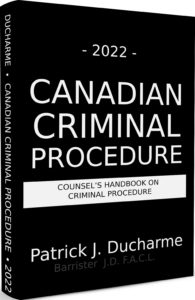In a criminal trial both types of evidence, direct or circumstantial, are admissible. In fact, our Judges instruct juries that one type of evidence is not to be considered “better” than another. The law treats both equally. The difference is that circumstantial evidence requires the trier of fact to conclude that the inference(s) they are urged to find on the evidence is/are the only rational inferences based upon what the witness observed, and, to also conclude that what the witness claims to have observed is accepted as accurate and truthful.

The above is the an excerpt of Patrick J Ducharme’s book, Canadian Criminal Procedure, available at Amazon or in bulk through MedicaLegal Publishing along with Criminal Trial Strategies.
Subscribe to Patrick Ducharme’s Youtube Channel
